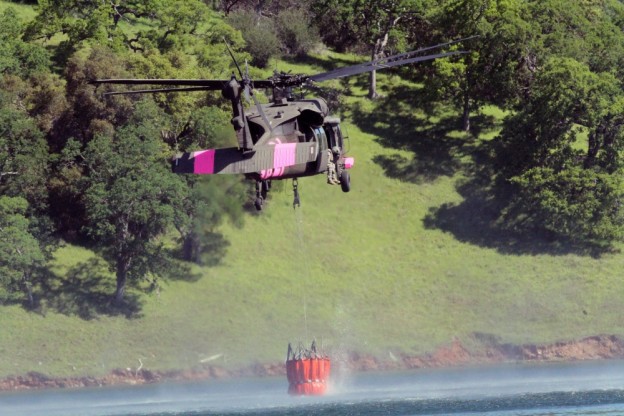At least 1,500 National Guard troops with more than two-dozen aircraft have deployed to fight the wildfires raging through Northern California and the Pacific Northwest.
The largest of several wildfire burning in California, the Mendocino Complex fire, has charred more than 300,000 acres, or 469 square miles, an area similar in size the Los Angeles, according to the state Department of Forestry. As of Wednesday, that fire is less than 50 percent contained.

More than 1,000 Army and Air National Guard troops have been deployed to fight that blaze and two other wildfires in the state. With them are seven HH-60 Pave Hawks performing medevac missions, two CH-47 Chinook heavylift helicopters, a UH-72 Lakota and one C-12 Huron transport aircraft, according to Army Guard Master Sgt. Michael Houk, a spokesmen for the National Guard Bureau.
In all, 13 Army and 7 Air Guard aircraft are deployed to California for firefighting or support activities. Air National guard assets include an RC-26 aerial surveillance aircraft, and four C-130H Hercules equipped with the modular aerial spray system (MASS) that can dump water and/or fire retardant on 190,000 acres a day.
In Oregon, three fires — the Klondike, Taylor Creek and South Umpqua Complex — have charred more than 102,000 acres. As of Aug. 8, 450 National Guard Troops had been sent to help contain them.
Two CH-47s, one HH-60 Pave Hawk, one UH-72 Lakota light utility helicopter and three UH-60s from the Texas National Guard are supporting fire suppression efforts in Oregon, Houk said.
Another 186 Guard troops are deployed in Washington, where at least seven wildfires are raging on more than 20,000 acres across the state, according to an incident map on the Washington Department of Natural Resources website.
An RC-26 spy plane is assisting with aerial surveillance and two UH-60 Black Hawks are dumping water from buckets on the blazes, Houk said.
“I don’t know what the future of those missions looks like right now,” Houk said. “They are going to stay there until they are not needed anymore.”
This fire season, fixed-wing medium-altitude long-endurance unmanned aerial systems are flying overhead in California and mapping the fire progression, according to the Pentagon. MQ-9 Reaper drones are supporting efforts to quench the Carr and Mendocino Complex fires in California.
Firefighters and the California Air National Guard’s 163rd Attack Wing, based at March Air Reserve Base, deployed an MQ-1 Predator drone over the 2013 Rim Fire in 2013 as a test of the aircraft’s utility gathering aerial data on wildfires. Since then, the wing has switched from Predators to the Reaper, which can transmit full-motion video and thermal imaging to firefighters in real time.
